This article was published in Scientific American’s former blog network and reflects the views of the author, not necessarily those of Scientific American
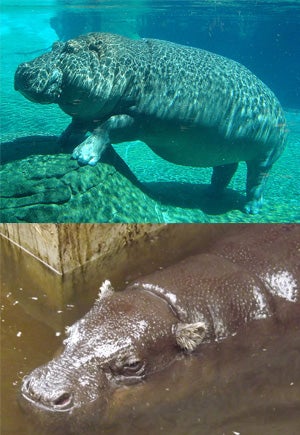
The two living hippos, both in captivity. Image at top by cloudzilla, CC BY 2.0. Image below by Darren Naish.
Hippos are represented today by just two species: the large, strongly amphibious Hippopotamus amphibius and the smaller, more terrestrial Pygmy hippo Hexaprotodon liberiensis*. As usual, the fossil record reveals a far greater number of species that were distributed over a far larger area than that associated with hippos today. In this article I aim to give a brief, succinct overview of hippo history.
* The Pygmy hippo was only discovered in 1849 and was initially (in 1852) deemed unique enough for its own genus, Choeropsis. During the 1970s it was noticed how similar this animal is to the fossil hippos included in Hexaprotodon (Coryndon 1977a, b) and the view that the species is merely a surviving member of the Hexaprotodon radiation more or less became mainstream during the 1990s. The problem is that Hexaprotodon as traditionally conceived seems to be a paraphyletic mess (Coryndon 1977a, b, Weston 2000, Boisserie & White 2004), and the lineage that includes the Pygmy hippo may not, after all, be all that close to the lineage that includes the type species of Hexaprotodon. Boisserie & White (2004) actually found the Pygmy hippo to be part of a lineage that forms the sister-group to the rest of Hippopotamidae, in which case a unique generic moniker is appropriate. A result of this confusion is that the literature currently features both names for this animal.
On supporting science journalism
If you're enjoying this article, consider supporting our award-winning journalism by subscribing. By purchasing a subscription you are helping to ensure the future of impactful stories about the discoveries and ideas shaping our world today.
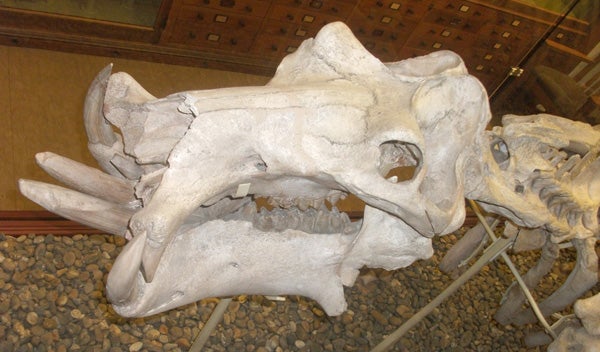
Skull of the Barrington hippo - a famous Pleistocene English specimen of Hi. amphibius on display at the Sedgwick Museum of Earth Sciences, University of Cambridge, UK. It's a composite of several different individuals. Photo by Darren Naish.
The oldest hippos. Hippos of the modern sort – crown-hippos – are not an especially ancient group. The oldest fossil hippos of modern sort (that is, of the clade Hippopotaminae within Hippopotamidae) are from the Upper Miocene of eastern Africa. More archaic hippos that are outside the crown group do extend the record back somewhat further, however. Kenyapotamus is known from the middle and Upper Miocene of Kenya, Tunisia and Ethiopia, and two additional taxa – Morotochoerus from Uganda and Kulutherium from Kenya, both from the Lower Miocene – appear to be close relatives (Orliac et al. 2010). Morotochoerus was originally identified as an anthracothere and Kulutherium has also been regarded as a member of this group at times. All are classified together within the hippopotamid clade Kenyapotaminae. If kenyapotamines really do belong together, they demonstrate the existence of a Miocene hippo clade that included both ‘peccary-sized’ taxa (Morotochoerus has been estimated at c 30 kg) and ‘hippo-sized’ taxa (Kenyapotamus perhaps exceeded 200 kg) (Orliac et al. 2010).
Hippos (that is, hippopotamids) are included within a more inclusive clade – Hippopotamoidea – that includes a set of Eocene and Oligocene taxa collected termed anthracotheres or anthracotheriids (Lihoreau et al. 2015). There’s a lot that could be said about these animals. Indeed, there’s a long-standing controversy as goes whether they really do include the ancestors of hippos or not (Pickford 2008) – but today isn’t the time for that. Anthracotheres take the history of the hippo lineage way back into the Paleogene.
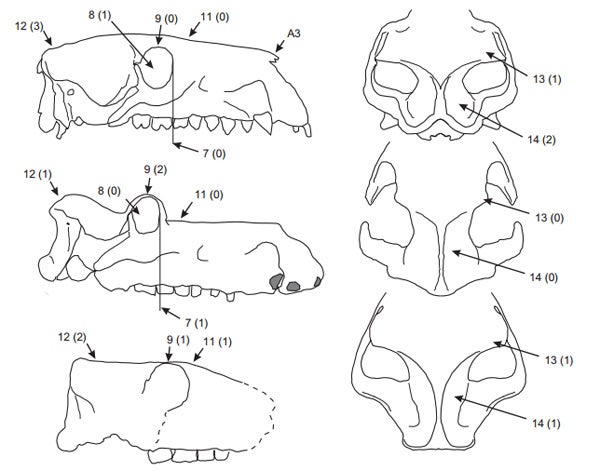
Substantial variation is present in hippo skulls, as is obvious from this figure from Boisserie (2005). At left (top to bottom): Hex. liberiensis, Hi. amphibius, Hex. mingoz. At right (top to bottom): Hi. amphibius, Hex. mingoz, Archaeopotamus harvardi.
Narrow-muzzled hippos and other Miocene forms. Among hippopotamine hippos, a number of archaic species are classified together within Archaeopotamus. These might be crown-hippos – that is, part of the clade that includes living hippos – but might not (Boisserie & Lihoreau 2006). And a problem with the concept of Archaeopotamus is that the species placed here differ substantially in size, proportions, and muzzle and jaw shape. Some (like A. harvardi) are small and narrow-muzzled and Hexaprotodon-like, and others are big and broad-muzzled, and Hippopotamus-like. This means that they might represent a grade, not a clade, and some authors simply don’t recognise Archaeopotamus at all, instead subsuming the species into Hexaprotodon (Boisserie & White 2004).
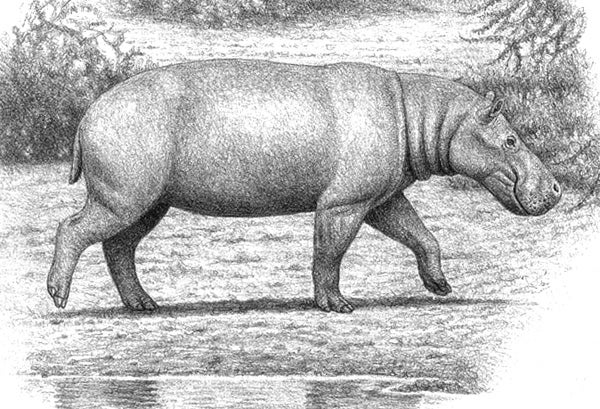
Life reconstruction of Archaeopotamus harvardi by Mauricio Anton, from Weston (2003).
A substantial number of fossil hippos are known from the Miocene, and also from the Pliocene and Pleistocene too. There are Asian taxa, like Hex. sivalensis and Hex. bruneti, numerous east African taxa, and (in the post-Miocene only) European and Mediterranean taxa. The best known of these animals is Hippopotamus gorgops, an extremely large east African hippo with orbits substantially elevated above the rest of the skull. The orbits of Hi. gorgops have rounded dorsal margins and must have looked like tall turrets. But it wasn’t the only hippo of this sort. Substantially elevated orbits are present in several others, including Hex. palaeoindicus, where the dorsal margins are, again, rounded, and Hex. karumensis, where the margins are tall and triangular.
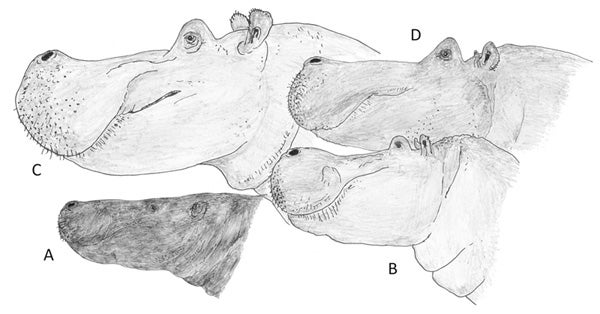
Hippo montage showing diversity in head shape. This illustration is one of several hippo figures from my in-prep textbook. Hint hint. Thanks to those providing support.
Hexaprotodonts, not all of which are hexaprotodont. So-called hexaprotodont hippos – typically classified together as Hexaprotodon – are so-named because several fossil species differ obviously from the Hippopotamus species in having six mandibular incisors, as opposed to four. They also tend to have shorter-crowned cheek teeth and a shallower mandibular symphysis than Hippopotamus species. Grooved canines are also more typical of hexaprotodonts than other hippos. However, six mandibular incisors are not present across all hippos thought to be hexaprotodonts: some have four incisors and others only have two. The living Pygmy hippo has four.
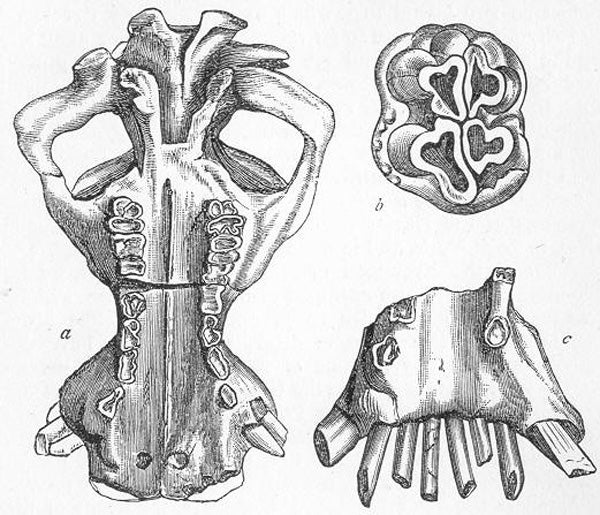
Skull, molar and symphyseal region of the lower jaw of Hex. sivalensis. Image in public domain.
Within the hexaprotodonts, a lineage where the third lower incisor is especially big is known from Ethiopia as well as India and Pakistan. The Asian species – Hex. sivalensis – is the type species for Hexaprotodon. These hippos also share a transversely narrow braincase and an exceptionally robust mandibular symphysis. They might have originated in Asia, their African representative (Hex. bruneti) thereby being an ‘Asian invader’ (Boisserie & White 2004).
Some hexaprotodont hippos are small relative to the Hippopotamus species. But this isn’t wholly true in view of species like Hex. karumensis. Hexaprotodont hippos thrived at high diversity in east Africa – as many as five species were contemporaneous in Ethiopia – until the end of the Pliocene when they declined and eventually died out, perhaps as a consequence of the climatic changes that occurred at this time (Boisserie & White 2004).
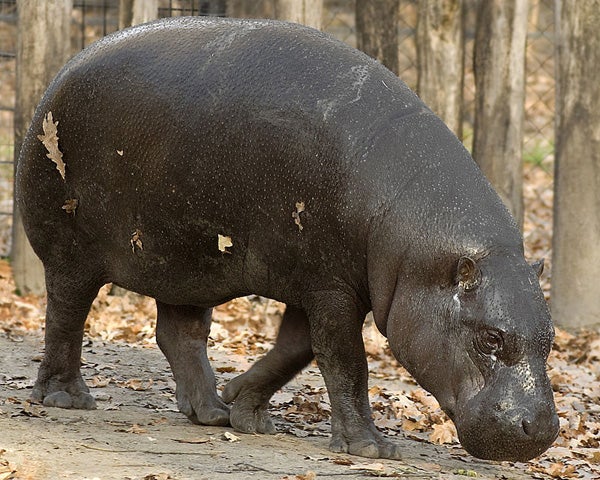
Pygmy hippo. Photo by Tommy, CC BY 2.0.
It’s looking increasingly likely that Hexaprotodon of tradition is a grade, not a clade. Several African species (including Hex. protamphibius) seem to be close relatives of Hippopotamus and therefore show that Hippopotamus is nested within Hexaprotodon as it’s ‘conventionally’ conceived. Indeed several authors have argued that the whole lot should be lumped together, in which case the name Hippopotamus wins priority. We won’t follow that here – my personal preference is that those ‘Hexaprotodon’ species closest to (and including) Hippopotamus should be recognised as Hippopotamus, and that the name Hexaprotodon should be restricted to the Asian clade that includes Hex. sivalensis.
Other fossil hippos. A few other ‘genus-level’ hippo taxa have been recognised. Trilobophorus from Hadar in Ethiopia supposedly has a unique lacrimal region but is (so far as I know) of uncertain phylogenetic position. Kenyapotamus from the Miocene of Kenya and Tunisia is poorly known but has simpler, smaller, more archaic teeth than other hippos and seems to be outside the Hexaprotodon + Hippopotamus clade (Boisserie 2005). Pickford (1983) thought Kenyapotamus distinct enough to warrant its own ‘subfamily’, Kenyapotaminae.
Saotherium from Chad was named by Boisserie (2005) for a Lower Pliocene hippo from Chad with an elongate braincase and an inclined mandibular symphysis. It was originally described as a member of Hexaprotodon (H. mingoz) but also seems to be outside the Hexaprotodon + Hippopotamus clade (Boisserie 2005). Some data indicates a close relationship between Saotherium and Choeropsis: both have a very similar symphysis (Boisserie 2005, Boisserie & Lihoreau 2006).
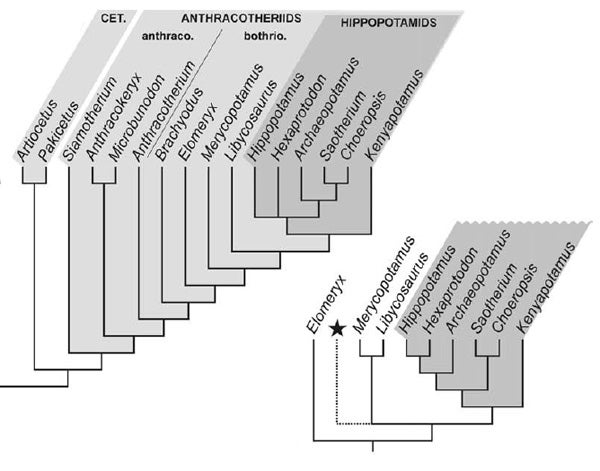
Phylogenetic hypotheses for hippos and their close relatives: two possible cladograms from Boisserie & Lihoreau (2006).
Hippos on islands. Hippos have been quite good at colonising islands and two cases of this are worth discussing. During the Miocene, the Mediterranean shrank and terrestrial animals of many sorts colonised the highlands that had previously been islands. The Mediterranean was later refilled, stranding those animals and meaning that they now became island endemics. Hippos were among these animals, and several dwarf forms now evolved on Crete, Cyprus, Sicily, Malta and Sardinia.
Because these hippos look somewhat odd compared to the others they’ve often been regarded as worthy of their genus: Phanourios. They have especially short toes compared to other hippos, a more digitigrade posture and more gracile limb bones, and some of them (those on Crete and Sicily) have unusual teeth suggesting specialised diets (Caloi & Palombo 1994, Sondaar 1994). However, these odd features are best interpreted as novelties associated with small size and a strongly terrestrial life, and most experts regard them as deeply nested with Hippopotamus. There are several species and the taxonomy is rather messy.
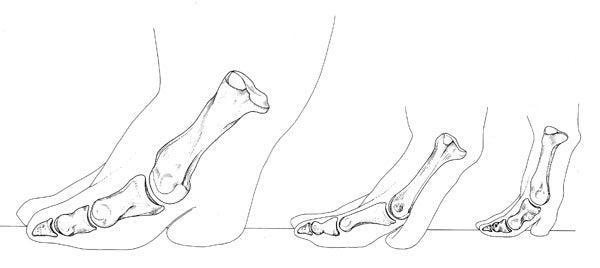
Island-dwelling Mediterranean hippos - like Phanourios minor at far right here - were more digitigrade and slender-limbed than Hi. amphibius (far left) and He. liberiensis (centre). Image from Sondaar (1994).
The second case concerns Madagascar. Hippos of two and perhaps three species occurred on Madagascar during the Pleistocene and Holocene at least (Stuenes 1989). How hippos got to Madagascar has been the source of some debate since the option of using a land-bridge is not viable, at least not unless you want to extend the hippo ghost lineage back to the Jurassic or Cretaceous (insert panbiogeography joke).
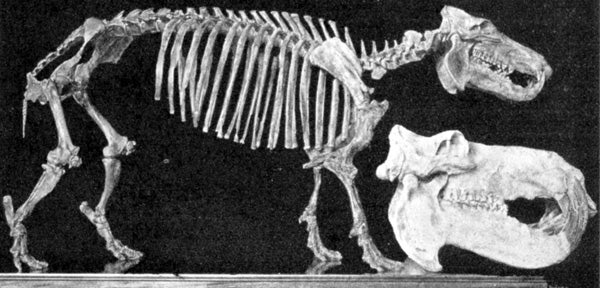
Skeleton of the dwarf Madagascan hippo Hi. madagascariensis to scale with the skull of Hi. amphibius. Image in public domain.
For years, the presence of hippos on Madagascar has been used (by myself, I admit, and others) as evidence that hippos simply must have swam across the Mozambique Channel – not only would this show that hippos are good dispersers able to cross marine barriers, it would also show once and for all that hippos really can swim, since you can’t bottom-walk across a seaway several hundred kilometres wide. And thus there was debate (most recently: Mazza 2014, 2015, van der Geer et al. 2015). In recent years it’s become better known that floating islands of vegetation and sediment – sometimes hundreds of metres in extent – are (and probably always have been) a genuine phenomenon, and that they might explain how certain organisms got from A to B without the aid of teleporters or aliens. Is it plausible that small hippos ‘rafted’ across the Mozambique Channel? It seems ridiculous, but not unduly so.
This was meant to be a very brief introduction to the world of hippo diversity and history. And it was fairly brief. But, as usual, there is so much more to say. I’ll come back to hippos at some point soon.
For previous Tet Zoo articles on artiodactyls, see...
PS - yes, we've undergone a site re-design. I'm not happy with how cramped things now appear...
Refs - -
Boisserie, J.-R. 2005. The phylogeny and taxonomy of Hippopotamidae (Mammalia: Artiodactyla): a review based on morphology and cladistic analysis. Zoological Journal of the Linnean Society 143, 1-26.
- . & Lihoreau, L. 2006. Emergence of Hippopotamidae: new scenarios. C. R. Palevol 5, 749-756.
- . & White, T. D. 2004. A new species of Pliocene Hippopotamidae from the Middle Awash, Ethiopia. Journal of Vertebrate Paleontology 24, 464-473.
Caloi, L. & Palombo, M. R. 1994. Functional aspects and ecological implications in Pleistocene endemic herbivores of Mediterranean islands. Historical Biology 8, 151-172.
Coryndon, S. C. 1977a. The taxonomy and nomenclature of the Hippopotamidae (Mammalia, Artiodactyla) and a description of two new fossil species. I. The nomenclature of the Hippopotamidae. Proceedings of the Koninklijke Nederlandse Akademie van Wetenschappen B 80, 61-71.
- . 1977b. The taxonomy and nomenclature of the Hippopotamidae (Mammalia, Artiodactyla) and a description of two new fossil species. II. A description of two new species Hexaprotodon. Proceedings of the Koninklijke Nederlandse Akademie van Wetenschappen B 80, 72-88.
Lihoreau, L., Boisserie, J.-R., Manthi, F. K. & Ducrocq, S. 2015. Hippos stem from the longest sequence of terrestrial cetartiodactyl evolution in Africa. Nature Communications, 2015; 6: 6264.
Mazza, P. P. A. 2014. If hippopotamuses cannot swim, how did they colonize islands? Lethaia 47, 494-499.
- . 2015. To swim or not to swim, that is the question: a reply to van der Geer et al. Lethaia Focus 48, 288-290.
Orliac, M., Boisserie, J.-R., MacLatchy, L. & Lihoreau, F. 2010. Early Miocene hippopotamids (Cetartiodactyla) constrain the phylogenetic and spatiotemporal settings of hippopotamid origin. Proceedings of the National Academy of Sciences 107, 11871-11876.
Pickford, M. 1983. On the origins of Hippopotamidae together with descriptions of two new species, a new genus and a new subfamily from the Miocene of Kenya. Géobios 16, 193–217.
- . 2008. The myth of the hippo-like anthracothere: the eternal problem of homology and convergence. Revista Española de Paleontología 23, 31-90.
Sondaar, P. Y. 1994. Paleoecology and evolutionary patterns in horses and island mammals. Historical Biology 7, 1-13.
Stuenes, S. 1989. Taxonomy, habits, and relationships of the subfossil Madagascan hippopotami Hippopotamus lemerlei and H. madagascariensis. Journal of Vertebrate Paleontology 9, 241-268.
van der Geer, A. A. E., Anastasakis, G. & Lyras, G. A. 2015. If hippopotamuses cannot swim, how did they colonize islands: a reply to Mazza. Lethaia Focus 48, 147-150.
Weston, E. M. 2000. A new species of hippopotamus Hexaprotodon lothagamensis (Mammalia: Hippopotamidae) from the Late Miocene of Kenya. Journal of Vertebrate Paleontology 20, 177-185.
- . 2003. Fossil Hippopotamidae from Lothagam. In Leakey, M. G. & Harris, J. M. (eds) Lothagam: the Dawn of Humanity in Eastern Africa. Columbia University Press (New York), pp. 441-472.